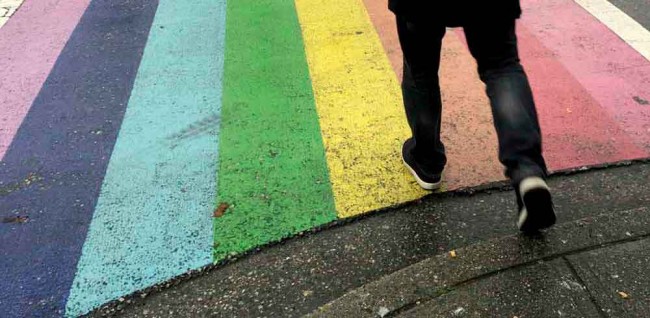
Photo Credit: Submitted
A Town for all Colours: Smithers gets a rainbow crosswalk
There’s something inherently cheerful about a rainbow, which is why it’s so often associated with happy things. Rainbows feature in songs, art, design, mythology, religion and literature. When I was a kid, the phrase “all the colours of the rainbow” referred to racial equality and acceptance of everyone, regardless of who you are, what you look like, where you come from, what you believe.
Since the late 1970s, one of the many things the rainbow has come to represent is the LGBTQ community—that’s lesbian, gay, bisexual, transgender and queer. Canada’s first rainbow crosswalk was painted in Vancouver in 2013 and dozens of other communities have since joined the movement. Smithers, Terrace and Prince Rupert are all poised to paint the colours on their streets this year, but there are some who say the rainbow is not for them.
Community conversation
“The reaction has been predictably mixed,” Smithers mayor Taylor Bachrach says. “There’s been a robust community conversation about this over the past several months.”
That conversation became fairly heated at times, but Bachrach believes that having the issue discussed will ultimately result in stronger communities. “One of the positive aspects of this is that the crosswalk, because it’s a physical thing, has brought the conversation out into the open. I think that can only lead to positive things down the road.”
In Smithers, the idea first came up when a local woman, Anna Ziegler, sent a letter to the town suggesting it.
“We discussed the idea at council and decided it would be appropriate and would move our community forward,” Bachrach says. “We do all sorts of different things to recognize people in our community: we erect statues and monuments, we name streets after people, we make symbolic gestures that tell a story about the kind of community that we are and the kind of community we want to be. I see this as a part of that realm of municipal activity.”
Mark Penninga, a resident who has vocally opposed the crosswalk, is the executive director of the Association for Reformed Political Action (ARPA), a non-profit most often associated with the Reformed Church community.
“We have to treat everybody with dignity, respect and love, regardless of ethnicity, race, sex, gender,” he says. “It’s so easy to say that putting a crosswalk on Main Street accomplishes that, and I would say ‘yeah right.’ Treating people with dignity and love is a verb—it’s something you do, not just something you paint on a road. It’s just a symbol.”
Opposition to LGBTQ symbolism is often based on religious belief or a particular worldview. Penninga says he believes the crosswalk promotes an ideology that is “harmful and hurtful” to people in the community.
“I’m not saying the rainbow has no meaning,” he continues. “What it does is it says we can define who we are when it comes to gender and sex, and there’s a lot of people, myself included, who say, ‘No, we don’t define who we are, we are made a certain way, we are designed.’ I believe we are created. We are made by someone who knew what He was doing, and that’s something we have to celebrate.”
Penninga stresses that he does not agree with discriminatory behaviour toward those who identify as LGBTQ, but still opposes the crosswalk.
“You hear a lot of terms like ‘diversity’ or that it promotes respect,” he explains. “What do they mean when they talk about diversity? Who gets to define a concept like that? Diversity has limits. How far does that extend? Who does the crosswalk actually include?”
Bachrach’s answer: everyone.
“At the heart of the symbolism of the rainbow crosswalk is people should feel safe to be who they are,” he says. “That’s an idea that extends to everyone in our community, regardless of their ethnicity, religion or sexual identity.”
He says the crosswalk has prompted all kinds of responses.
“One of the most moving things for me has been having parents of kids who grew up in Smithers gay or lesbian or questioning their identity say, ‘This is such an important thing we’re doing, because my kid grew up facing discrimination and had to leave.’ Those kinds of comments suggest to me that we’re moving in the right direction.”
Growing up
Perry Rath is a teacher at Smithers Secondary School and co-founder of the Gender Sexuality Alliance (GSA), an advocacy and support group for high-school students.
“Last fall, the debate really polarized the community,” Rath says. “Our LGBTQ youth have been watching this unfold and we’ve talked about how it affects them. They feel they are at the heart of the debate, but also feel on the outside.”
Earlier this year, Rath and the GSA brought an educational organization called Out in Schools to Smithers. The group teaches about gender identity and acceptance through interactive presentations and short films. One video made by a Lower Mainland student ends with the words, “I am me, and that’s all that matters.” The message is pretty simple: tolerance, acceptance, empathy, understanding.
Matt Peeters, a grade 12 student and member of the GSA, says he’s looking forward to seeing the rainbow crosswalk. “It promotes awareness,” he says. “And it really shows that the roots of unacceptance aren’t OK anymore.”
Bachrach agrees: “I want young people to know that wherever they fall on the spectrum, Smithers is a place they can call home, and it’s not somewhere they have to leave,” he says. “There are a lot of youth who have found Smithers not welcoming and have left for other communities. And those folks have tons to contribute to our community.”
Colourful communities
Public art can mean a lot of different things to different people. Maybe the crosswalk is just a cheerful splash of colour to some, while for others it’s an important symbol of acceptance. Does it express an ideology and single out a particular group of people? Sure, but so does the Wet’suwet’en carving at Smithers’ Bovill Square.
“We wanted to acknowledge the Wet’suwet’en members of our community,” Bachrach says of the carving. “I think it’s added to our downtown and I see tourists taking pictures of it all the time. It’s a statement about our community; it tells a story about who we are.”
He says the rainbow crosswalk falls into the same category. Penninga argues that the town is using its position of authority to impose this ideology.
“It’s not the role of the municipal government to make minority groups feel like they are not discriminated against,” he says. “It’s not the role of the municipal government to make people feel included.”
In response, Bachrach says he feels that that is one of the most important roles of municipal government.
“The ultimate goal is to make our community a place that is free of discrimination,” he says. “Helping people feel at home and helping people feel safe lie at the core of community and as community leaders we have a responsibility to make sure both of those things are true for everyone who lives here.
“We are going to be strongest if we welcome diversity and are as inclusive as possible,” he continues. “We want people to come and make this community their home, and to do cool stuff here: do art, create businesses, raise families. In my mind, the wider the range of diverse people we can attract to come be Smithereens, the more resilient we’re going to be and ultimately the more successful we’re going to be as a community.”
Does a rainbow crosswalk achieve all this? Time will tell. And in the meantime, whatever it means, hopefully these colourful crosswalks makes daily life a little more cheerful and crossing the street a bit more fun.




